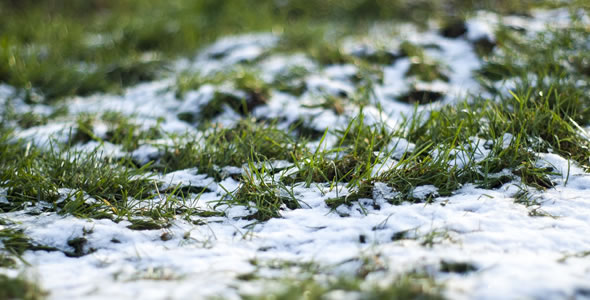Tips to Help Your Lawn Survive the Winter
11/15/2023 9:13:51 AM
By: Katie Kuchta, LawnStarter
As fun as summer is, it often leaves your lawn looking the worse for wear. Days with too much sun, traffic, and too little water; invasions by weeds, pests, diseases—perfectly understandable if the lawn is looking a bit bedraggled in the fall. As the days get cooler, you'll mow shorter, water less, overseed, and fertilize. Here are some additional ways to help your lawn survive the winter and be ready to green up hale and hardy in the spring.

1. Dethatch the Soil
Lawns overrun with thatch are prone to winter injury. The thatch shelters disease-causing organisms such as snow mold. There are two ways to deal with it. Core aeration punches cylindrical plugs out of the lawn, loosening the soil and stirring up the microorganisms that will break up the thatch. Dethatching also helps promote stronger roots, which is something you will definitely want for the winter months.
Dethatching done with a vertical mower. The mower's blades cut down into the thatch without damaging the healthy grass. The thatch is brought up to the surface, raked up, and under the best conditions, added to a compost pile.
2. Check Your Soil's pH
Late fall is the best time to test your soil pH and make any necessary corrections. If your soil is too acidic, it is not going to get the nutrients it needs over the winter. You can get the results of your test from a lab or your local cooperative extension. pH meters are very affordable–$15-25, and you don't have to wait for the results. Be sure to follow the manufacturer instructions for collecting and testing your soil.
3. Get Rid of the Weeds
You can dig out the weeds or kill them with boiling water or vinegar spray. If your lawn is too far gone for that, keep mowing your grass throughout winter at its recommended height. Most winter weeds can't survive repeated mowing and will die. Use a bag attachment on your mower to catch seeds so they won't get back on the lawn and germinate.
4. Remove Leaves Before Snowfall
Leaves block sunlight, smother the grass and prevent moisture from evaporating on the lawn. Rake up the leaves to add to your compost pile or leave them on the lawn. Chop them into small pieces with a mulching mower and let them return their nutrients to the soil.
5. Remove Everything Else Also
Give your lawn the same respect in the winter as you would in the summer and remove any additional "junk." To avoid large dead patches in the spring, keep the assorted debris, abandoned bicycles or toys, and errant lawn furniture off the lawn.
6. Keep Off the Lawn
It seems harmless to walk across the short, brown, dormant grass, but it is, in fact, more vulnerable to traffic than that summer green grass is. You might feel as though you're walking on snow and ice, but those winter boots are stomping your grass to death. Keep the sidewalks clear of ice and snow to discourage guests from cutting across the lawn. You already know not to park a car on your lawn, right? That's the fastest way to kill the good grass and make room for crabgrass and other types of weeds to move in.
7. Pull Out Your Annuals
Annuals die every year. If you leave them, the dead plants become luxury condos for lawn- and garden-killing insects. Before winter starts, pull up the spent plants in it's entirety–including the roots. Discard of the remnants as needed by disposing them into your compost pile.
8. Mulch the Perennials
Perennials might look like they are dying, but they are merely going dormant. They will however, return again and brighten your lawn in the spring. Make sure to trim perennials down to the surface level, this keeps the root intact throughout the winter. If your lawn is blanketed with insulating snow in the winter, the perennials will be fine. If there is little or no snow cover in your region, you need to protect the perennials with two or three inches of mulch, such as shredded leaves or pine needles.